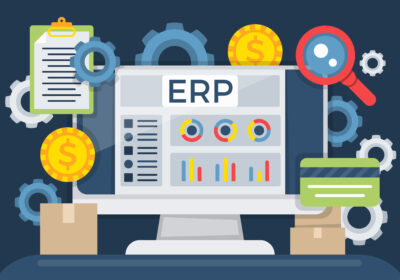In today’s data-driven business world, Enterprise Resource Planning (ERP) software plays a pivotal role in streamlining operations, optimizing resource allocation, and gaining valuable insights. However, implementing an ERP system is not a one-time event; it’s a strategic journey with distinct stages. This blog serves as your roadmap, exploring the eight crucial stages of the ERP implementation lifecycle, empowering you to make informed decisions and ensure a successful transition.
Stage 1: Pre-Evaluation and Needs Assessment:
The foundation of a successful ERP implementation lies in a thorough understanding of your business needs. This initial stage involves:
- Identifying Business Requirements: Evaluate your current business processes and pinpoint areas for improvement. Define the functionalities you require from the ERP system, considering factors like finance, inventory management, supply chain, customer relationship management (CRM), and human resource management (HRM).
- Project Justification: Develop a business case that outlines the expected benefits of implementing an ERP system. This includes quantifying potential cost savings, improved efficiency, and enhanced decision-making capabilities.
- Organizational Change Management: Implementing an ERP system will impact your entire organization. Develop a change management strategy to address employee concerns, provide training, and foster a culture of adoption.
Stage 2: Package Selection:
With a clear understanding of your needs, it’s time to explore the ERP software landscape. Here’s what this stage entails:
- Market Research: Research leading ERP vendors and their offerings, considering factors like industry experience, feature sets, scalability, and pricing models. Shortlist a few vendors that align with your budget and business requirements.
- Software Demonstrations: Schedule demonstrations with shortlisted vendors to gain firsthand experience with their ERP systems. Evaluate functionalities, user interface (UI) usability, and compatibility with your existing infrastructure.
- Vendor Selection: Carefully evaluate proposals from shortlisted vendors. Consider factors like total cost of ownership (TCO), implementation timelines, customization options, and ongoing support services.
Stage 3: Project Planning and Blueprinting:
Once you’ve chosen your ERP vendor, it’s time to meticulously plan the implementation process. This stage involves:
- Project Team Formation: Assemble a cross-functional project team with representatives from various departments who will be impacted by the ERP system.
- Project Scope Definition: Clearly define the scope of the project, outlining functionalities to be implemented, customization needs, and system integration requirements.
- Implementation Plan Development: Develop a detailed project plan with timelines, milestones, resource allocation, and risk mitigation strategies.
Stage 4: Gap Analysis and Business Process Reengineering:
This stage focuses on bridging the gap between your existing business processes and the functionalities offered by the ERP system:
- Gap Analysis: Identify discrepancies between your current processes and the ERP system’s capabilities. This analysis helps determine what processes need to be adapted or re-engineered to work seamlessly with the new system.
- Business Process Reengineering (BPR): Redesign and optimize processes where necessary to align with the ERP system. This might involve streamlining workflows, eliminating redundancies, and improving data consistency.
Stage 5: Data Migration and System Configuration:
Here’s where your existing data gets migrated to the new ERP system, and configurations are tailored to your specific needs:
- Data Migration Strategy: Develop a comprehensive strategy for migrating data from your existing systems to the ERP system. This includes data cleansing, mapping, and ensuring data integrity throughout the migration process.
- System Configuration: Configure the ERP system according to your defined functionalities, security protocols, and user permissions. This stage also involves integrating the ERP system with any existing applications.
Stage 6: Training and User Adoption:
Successful ERP implementation hinges on user adoption. This stage focuses on equipping your team with the necessary knowledge and skills:
- Comprehensive Training: Develop a training program for all user groups, covering system functionalities, workflows, and best practices. Training can be delivered through instructor-led sessions, online modules, or a combination of both.
- Change Management Strategy: Reiterate the value proposition of the ERP system and address user concerns throughout the implementation process. Foster a culture of openness and encourage feedback to ensure smooth user adoption.
Stage 7: Testing and Go-Live:
Before going live, thorough testing is crucial to ensure the system functions as intended:
- Unit Testing: Test individual modules of the ERP system to identify and address any bugs or errors.
- Integration Testing: Ensure seamless integration between the ERP system and your existing applications.
- User Acceptance Testing (UAT): Empower end users to test the system and identify any usability issues before going live.
Stage 8: Post-Implementation Support and Maintenance
A successful ERP implementation doesn’t end with going live. Ongoing support and maintenance are essential to maximize the system’s value:
- Post-Go-Live Support: Provide ongoing support to address any initial challenges users may face after system rollout. This might include troubleshooting issues, answering questions, and offering additional training.
- System Monitoring and Optimization: Continuously monitor system performance and identify areas for improvement. Utilize system reports and analytics to optimize workflows and ensure efficient resource allocation.
- Regular Updates and Upgrades: Stay updated with the latest software patches, security updates, and new features offered by the vendor. Implement these updates strategically to maintain system stability and leverage the latest functionalities.
- User Feedback and Continuous Improvement: Encourage user feedback and suggestions for improvement. Utilize this feedback to identify areas for further process optimization and enhance system usability.
Conclusion:
The ERP implementation life cycle is a strategic journey that requires careful planning, collaboration, and ongoing support. By understanding the eight crucial stages outlined in this blog, you can navigate the process with greater confidence and ensure a successful transition. Remember, a successful ERP implementation is not just about technology; it’s about transforming your business processes, empowering your workforce, and achieving your long-term strategic goals. Embrace a collaborative approach, prioritize user adoption, and continuously optimize your system to unlock the full potential of your ERP investment.
Additional Considerations:
- Data Security: Throughout the implementation lifecycle, prioritize data security. Implement robust access controls, data encryption, and regular backups to safeguard sensitive information.
- Vendor Relationship Management: Maintain a strong relationship with your ERP vendor. Leverage their expertise throughout the implementation process and beyond.
- Scalability and Future Needs: Consider future business growth when selecting and implementing an ERP system. Choose a solution that can scale to accommodate your evolving needs.
By following these guidelines and staying committed to continuous improvement, you can ensure your ERP system remains a valuable asset, driving operational excellence and propelling your business towards sustainable growth and success.





